
Samsmaranam dedicated to Guru Kelucharan Mohapatra on
his tenth death anniversary
- Nita Vidyarthi
e-mail: nitavidyarthi@gmail.com
Photos: Arabinda Mahapatra
May 24, 2014
Guru Kelucharan Mohapatra took Odissi to different parts
of the world to its remotest corner. His disciples are
distributed the world over. They are dancers of high
calibre and distinguished teachers who carry forward his
legacy and style with great elan, including his
daughter-in-law, Sujata and his young granddaughter
Preetisha, not to forget his illustrious son Guru
Ratikant, a brilliant dancer/choreographer, a virtuoso in
his own right, a very able administrator, and director of
Srjan.
Slide show of Day 1 (April 7, 2014)
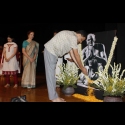 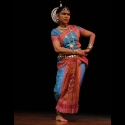 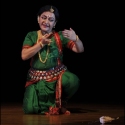 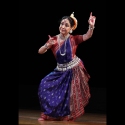
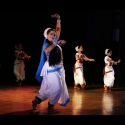 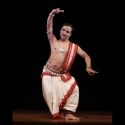 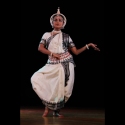 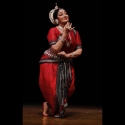
On Kelubabu’s 10th death anniversary, about 20
distinguished senior disciples from different parts of the
country paid sober tribute to their guru by rendering some
of his very best compositions with an offering of a
garland of dance. Srjan in collaboration with Art Vision
organized a three-day festival Samsmaranam (7th to 9th
April 2014) in remembrance of this great guru at Rabindra
Mandap, Bhubaneswar, where vocal and instrumental music
were also included. The festival was inaugurated by The
Commissioner-cum-Secretary, Department of Tourism and
Culture, Dr. Arbind Padhi and Usha Padhi, Department of
Education, in presence of renowned Odissi dancer Dr.
Priyambada Mohanty Hejmadi and other dignitaries
through a solemn ceremony after which the recitals began
with a Mangalacharan by senior disciple Kumkum Mohanty,
composed for her in 1981. Aloka Kanungo from Kolkata
presented a Kha Champu “Khelalola Khanja Naki” composed in
1981 for the NCPA Champu Ballet. Both from Delhi, Sharon
Lowen presented “Sakhi he” and Madhavi Mudgal, known for
her sensitive abhinaya, rendered the Singhendra madhyam,
ektali based “Prana sangini re” composed for her around
1976. Each evening included a couple of Pallavis, a group
presentation apart from abhinaya pieces. The inaugural
evening had Panchanan Bhuyan with the Gotipua tradition
presenting Kirwani Pallavi and Rina Jana from Kolkata with
Behag Pallavi. Meera Das and troupe Gunjan Dance Academy
from Cuttack concluded the evening with Meera and “Moods
of Rhythm,” both choreographed by her.
Slide show of Day 2 (April 8, 2014)
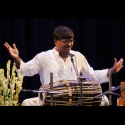 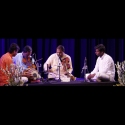 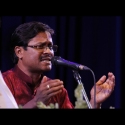 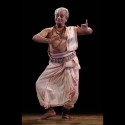 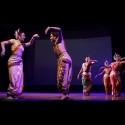
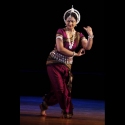 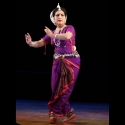
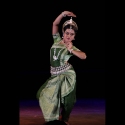 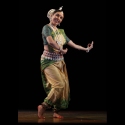 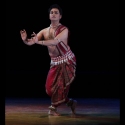
The morning session was devoted entirely to music,
beginning with the recital of the acclaimed mardal player
Sachidananda Das. Guru Kelucharan Mohapatra encouraged him
and was his inspiration and he adored the way
Guruji played the instrument. Das demonstrated the
different aspects of mardal playing like orasa, ukuta,
bhauri, kaudi, ragad, including the classical style of
Ranighati sankirtan bols in the Master’s composition of
Ardhanariswar. Violinist Ramesh Chandra Das played Misra
Kafi in taal khemta and jhula spicing up his recital with
witty anecdotes about Guruji and his close associate, the
music composer Pandit Bhubaneswar Mishra. Son Sarada
Prassana at present in Benaras Hindu University joined him
to present raag Bhopali, madhyalaya, in the Carnatic
vein, solely for entertainment. The Jhulan Geeta “Jholey
Jholey Radha Govinda” was followed by the
soul-stirring ‘Vande Mataram’ in raag Desh. Bijay Kumar
Jena, the reputed classical Odissi vocalist mentioned with
reverence how much he owed to Guruji for his singing
career and that he was like his son (putrabat).
According to Jena, he came in contact with Guruji by
chance when Pandit Raghunath Panigrahi could not manage to
reach the studio for the recording of “Krishna Sudama” and
Jena was called to step in. Since then Jena was his
favourite and sang for him. The singer began with a very
appealing raganga “Nikunjey jana jana braja juvaraaj
Kanha” in raga Bajrakanti after a short alaap with an
impressive mardal support by Sachidananda Das. “Aaj eki
gumano re” (raga Chandrakanta) and “Chaho chaho re
sangini” (raga Nata) were pleasing as was the
concluding natyanga song “Saja kanja nayana” used
for Kumkum Mohanty’s abhinaya.
The evening had a mesmerizing beginning with the raga
Mohana based mangalacharan “Mannikyaveena” by veteran
Ramani Ranjan Jena. The dancer offered his body and soul
to the piece composed in 1965 for Sanjukta Panigrahi, the
grace of his hastas being a real treat. Another elegant
abhinaya “Tolagi Gopadanda” first composed for Kumkum
Mohanty in 1966 was presented by Pranati Mohanty. Young
Subikash Mukherjee from Kolkata looked good in the
ashtapadi “Rasey harim eha.” Rajashree Praharaj’s skilled
performance of Hamsadhwani Pallavi first composed in 1979
for Kumkum Mohanty, reflected both her understanding of
rhythm and the power to execute it competently. Sharmila
Mukerjee from Bangalore effortlessly executed the Mohana
Pallavi but she could have avoided the fixed smile
throughout the performance.
Well trained dancers of Art Vision under the guidance of
Ileana Citaristi presented a well-rehearsed not often seen
Belawari Pallavi followed by a dazzling thematic
presentation “Mahanadi” based on an age-old poem by Devdas
Chottray on the saga of the great river of Odisha and a
cradle of Odia culture. The myths related to the various
places located along its course like that of Sabari,
Visuavasu, Lalita-Vidyapati, and the escape of Lord
Jagannath who hid in Patali Cuttack from the ire of
Kalapahada and finally Bali Jatra on Kartik Purnima was
presented through a fine visually pleasing imagery by the
competent dancers with Ileana and Saswat Joshi in duet
acting as the sutradhar. Though the movements of the duet
by the sutradhars were repetitive, the fascinating scene
of the waves with the dancers, holding hands while
portraying crests and troughs with the projection of the
flowing river on the screen at the back of the stage was
highly praiseworthy. Lakshmikant Palit’s music added
flavour to the whole production.
Slide show of Day 3 (April 9, 2014)
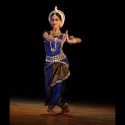 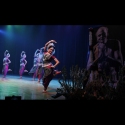 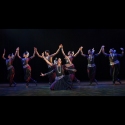
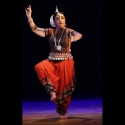
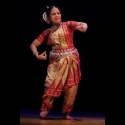
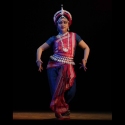
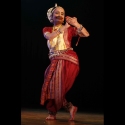
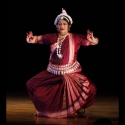
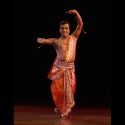
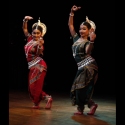
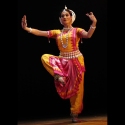
It was a morning to watch how the very young and upcoming
Odissi dancers displayed their talents and there could not
have been a better choice than the very talented Preetisha
Mohapatra, who has gradually bloomed into a very fine and
competent dancer to open the session. Her mangalacharan
“Namami bighnaraja twam” showed her elegance, training and
perfection of equilibrium. For the first time, Art Vision
students Bharati Kashish and Divya Subakar presented
an Arabi Pallavi on stage and Batu was presented by
Reebdhita Barua and Atmaja Bhaduri of Srjan. An intimate
discussion on the personal experiences with Guruji by his
disciples and friends brought to the fore the man and the
great human being with his unparalleled qualities to
those who knew him and those who did not. It was a
joy-tear–memory filled
emotional session with Kumkum Mohanty’s mimicry adding
that humorous flavour to the somewhat heavy morning. The
film “The Legend Speaks” on Guruji’s life by Ratikant was
a welcome addition.
The evening extended the mood with a fine mangalacharan by
the senior most Odissi dancer Dr. Minati Misra. It was
rewarding to watch her perform a broad chauka in
Shankaracharya’s ‘Jagannath Ashtakam’ set to Balakrushna
Das’ music composed in 1974 for the International
Yoga Youth Festival in Switzerland. Debi Basu’s “Patha
chhadi de” (composed in 1966), Daksha Mashruwala’s “Ahi
neela shaila” (composed in1982 for Kumkum Mohanty), Kumkum
Lal’s “Nahike kari dela” with the old world charm composed
specially for Guruma Lakshmipriya Mohapatra in 1946 with
traditional music was interesting. Dona Ganguly presented
“Kuru yadu nandana” composed in 1967 for Sonal Mansingh
and Rajib Bhattacharya presented Kalyan Pallavi
(1959). Sujata Mohapatra’s “Ardhanarishwar” composed
for Sanjukta Panigrahi in 1977 had her usual
splendor, offering a poised reverence with open hands
sitting in front of her Guru’s portrait kept at the front
right hand corner of the stage. The grand finale was
Srjan’s ‘Samakala’ and ‘Bhaja Govindam,’ both spectacular
pieces choreographed by Ratikant by weaving
chiselled geometric patterns and executed by dancers
competent and confident, to soul-stirring music.
The high point of the dignified festival lies not
only in its feast of dance presentation by the best in the
country but in the rekindling and realisation of the bond
that Guru Kelucharan Mohapatra had established with
his shishyas with Ratikant extending his hands to
make it even stronger. An exhibition of old photographs
brought back memories for many! A special mention for the
transient glance of Guruji’s photograph on the back of the
stage when the curtain opened for a moment.
Dr. Nita Vidyarthi is a critic of performing arts,
specialising in dance, dance theatre and expressions and
is a regular contributor to The Hindu, and the Statesman
Kolkata in dance, vocal music and theatre. She is
trained in Kathak, Bharatanatyam and Manipuri as well as
vocal, semi-classical music and Rabindra Sangeet. A
Science communicator, Ph.D. in Polymer Science,
Commonwealth Scholar and a retired Professor of
Chemistry, Nita devotes most of her time to dance and
theatre writing.
|

